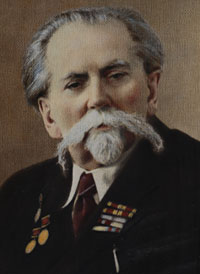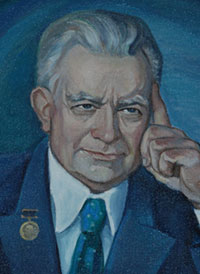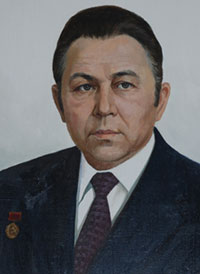History of institute
 Federal public budgetary scientific institution "All-Russian Scientific Research Institute of Fundamental and Applied Parasitology of Animals and Plants named after K.I. Skryabin", it is created in 1932, with active participation of the world famous scientist-gelmintologa, academician and his first director K.I. Skryabin, on the basis of gelmintologichesky department of the All-Russian institute of experimental therapy as ASRI of Parasitology named after K.I. Skryabin.
Federal public budgetary scientific institution "All-Russian Scientific Research Institute of Fundamental and Applied Parasitology of Animals and Plants named after K.I. Skryabin", it is created in 1932, with active participation of the world famous scientist-gelmintologa, academician and his first director K.I. Skryabin, on the basis of gelmintologichesky department of the All-Russian institute of experimental therapy as ASRI of Parasitology named after K.I. Skryabin.In 1935 at institute the Academic Council is organized, and in 1938 he has acquired the right for award of candidates of veterinary, medical and biological sciences on a gelmintologiya.
In 1939 the name of the academician K.I. Scriabin has been appropriated to institute, and he began to be called as Scientific Research Institute Parasitology named after K.I. Skryabin (VIGIS).
In 1955. The right of reception to protection of theses for degree of the doctor of veterinary and biological sciences is presented to an academic council of VIGIS.
In 1961 the Kurilovsky vetuchastok of Podolsk district veterinary clinic transformed to experimental base of Podolsk department of VIGIS has been transferred to institute.
For success achieved in development and introduction in production of measures of fight and prevention of helminthoses of animals the institute in 1967 is awarded the order the Red Banner and began to be called "Scientific Research Institute Parasitology named after K.I. Skryabin".

In 1971 the structure of institute has included Department of studying of fitonematodoz.
In 1971 VIGIS is approved by leading research institute on development and improvement of bases of prevention and measures of elimination of helminthoses of farm animals and called All-Union Awards of the Labour Red Banner research institute of a gelmintologiya of a name of the academician K.I. Scriabin.
In 1991 the institute is transferred to the Russian academy of agricultural sciences and has received a new name State research institute of a gelmintologiya of K.I. Scriabin of the Russian academy of agricultural sciences (The wildebeest VYGIS RAAS).
In 2014 the institute has been given the status of FGBNU and he has received the new name:
Federal public budgetary scientific institution "Scientific Research Institute Parasitology named after K.I. Skryabin"
VIGIS is on B. Cheremushkinskaya Street, 28 in a complex of structures of Stables of the estate Cheryomushki. The stables - one of the Moscow architectural pearls, as well as the palace of the estate, are built of a stone, decorated with white columns and towers. Buildings of Stables form a vicious circle. In his center on a low stone pedestal a bronze sculpture – a bust of the organizer of institute and gelmintologichesky science in the Soviet Union, the Hero of Socialist Work, the winner Leninskaya and the State awards, the academician Konstantin Ivanovich Skryabin.
On the building of institute memorial boards in memory of prominent scientists-gelmintologov are established: second director of VIGIS, full member of VASHNIL, winner of the State award USSR Vladimir Stepanovich Yershov and third director of VIGIS, full member Rosselkhozakademiya, honored worker of science of the Russian Federation, winner of the State award USSR Andrey Stepanovich Bessonov.
 The building of institute is included in number of the monuments which are subject to protection as a monument of the state value.
The building of institute is included in number of the monuments which are subject to protection as a monument of the state value.The institute worked and prominent domestic scientists work now: K.I. Skryabin, R. S. Schulz, I.V. Orlov, A.M. Petrov, V. S. Yershov, D. N. Antipin, E.E. Shumakovich, V. I. Petrochenko, N. V. Demidov, A.S. Bessonov, A.V. Uspensky, V. V. Gorokhov, V. F. Nikitin, etc.
As a result of long-term work of group of scientists of institute, considerable success in the solution of both theoretical, and practical problems of a gelmintologiya is achieved.
The specific structure and morphology is studied, the taxonomy of separate groups of helminths is developed that has allowed to carry out radical reorganization of systematization of nematodes, trematodes, cestodes and I akantotsefat, to cardinally reform it and to bring under her the phylogenetic base.
Biological cycles more than 200 types of pathogenic helminths are deciphered. Regularities of formation and functioning of parasitic systems and their separate components in the conditions of natural and agricultural biocenoses are revealed.
New data on an epizootologiya more than 70 nosological units of helminths of cattle, bisons, northern and antler deer, sheep, goats, marals, the Caucasian round, horses, donkeys, mules, pigs, boars, dogs, cats, fur animals, rabbits, laboratory animals, hens, geese, ducks, turkeys, reptiles and pond fishes are obtained.
These works were scientific base for creation of prevention of helminthoses. Biological bases of prevention of helminthoses are developed and widely introduced.
Complex researches on an epizootologiya and epidemiology of diseases, the general for animals and the person are carried out. epidemiological communication between domestic, wild animals and the person at the gelmintozoonozakh is revealed.
Evidence-based systems of measures of fight against the main helminthoses of farm animals are developed. The ecology of intermediate owners of helminths and influence of bacteria, an actinomycete, predatory mushrooms on helminths is studied.
The methodology of monitoring of parazitoz in the country for the purpose of forecasting of an epizootic situation and correction of systems of fight against parasitic diseases is developed.
Researches on clarification of an ekologo-epizootic situation on parasitic diseases of elks, antler deer and boars in especially protected natural territories are conducted.
Modern data on taxonomy, biology and ecology of helminths, therapy and prevention of parazitoz of wild animals are obtained. recommendations about carrying out the antiparasitic actions directed to protection of wild animals from parazitoz, increase in number and enrichment of their specific structure are developed.
The complex of actions providing minimization of environmental pollution with activators of parazitoz with animal husbandry waste is developed. In norms of technological design of objects of animal husbandry the main requirements of prevention of parasitic diseases, and in systems of natural and security constructions – requirements for ecological safety of waste are put.
Change of morphological structure and biochemical indicators of blood, metabolism and activity of fermental systems at helminthoses is studied; degree and nature of restoration of exchange processes at animals after a degelmintization.
In the course of studying of pathogenesis, clinic and a patomorfologiya of helminthoses the consistent patterns characterizing stages of development of these diseases are determined. Especially heavy course of helminthoses is the share of the early migratory stage characteristic ostroprotekayushchy inflammatory processes.
Patomorfologichesky changes with parasitizing of helminths in an organism of nonspecific owners where they didn't reach puberty are studied, but were a serious pathological factor of traumatic and allergic character for these animal species.
For the first time in world practice the original technology and a complex of devices for sanitary and veterinary examination of meat and fish production on parazitoza is developed and widely introduced.
Methods of lifetime and posthumous diagnostics of a number of helminthoses, methods of a gelmintologichesky assessment of reservoirs, pastures, inspection methods on causative agents of helminthoses of livestock rooms, objects of external environment, sowings of agricultural crops are developed.
Immunogenesis at a number of helminthoses is studied, anti-gene structure of helminths, the immune answer of an organism of the owner to an invasive anti-gene and possibilities of their use for lifetime diagnostics of parasitic zoonoz.
For the first time in Russia the institute has carried out works on creation of genetically engineered designs on the basis of recombinant DNA of ekhinokokk and трихинелл and the biological preparation for immunodiagnostics and immunoprevention the larvalnykh of tsestodoz is created. The amplifikatsionny test system on the basis of PTsR-PD of the Russian Federation is developed for a genomic tipirovaniye of isolates of ekhinokokk and trichinella.
Methods of cultivation of cells of helminths in artificial nutrient mediums are developed, the cellular cultures, sekretiruyushchy biologically active agents possessing diagnostic and protective properties are received.
The institute always paid to questions of development of means and ways of therapy of helminthoses of animals much attention as the degelmintization is one of the dominating links the protivogelmintoznykh of actions.
New technologies of receiving antiparasitic, biopolymer, the liposomnykh, the microencapsulated and combined means are created. Methods and means of a disinvasion of livestock rooms and the soil from causative agents of helminthoses are developed.
The pharmacokinetics and farmakotoksikologichesky properties of new anti-parasitic preparations, their influence on dairy efficiency, body weight gain, the immune status, reproductive function and their metabolites which are allocated with excrement the lechenykh of animals in the soil, water, plants and their influence on activity of koprobiont is studied.
The specific structure, areas and injuriousness of the most pathogenic phytohelminths and regularity of a course of epiphytoties in various zones of the country is studied. For the first time in the territory of the former USSR more than 200 phytonematodes are revealed, from them 50 types are described as new to science. Measures of fight against tsistoobrazuyushchy nematodes of potatoes, oats and sugar beet, with a stem nematode of potatoes, onions and garlic, with a rice nematode are proposed. The basic possibility of application of a serologichesky method of diagnosis of phytohelminthoses is for the first time established.
For a cycle of works "Biological bases of prevention of helminthoses of farm animals" in 1977 have been conferred a rank of the winner State awards of the USSR of 9 scientists of VIGIS: the academician of Of agricultural Sciences Yershov V. S., professors – Bessonov A.S., Demidov N. V., Kotelnikov G. A., Kuznetsov M. I., Panasyuk D. I., Petrochenko V. I., Tsvetaeva N. P., Shumakovich E.E.
For development of a new antgelmintik – a political rheme and his introduction in practice of treatment and prevention of helminthoses of animals to group of scientists of VIGIS as a part of professors Veselova T.P. and Arkhipov I.A., candidates of science Musayev M. B. and Savchenko N. N. the award of the Government of the Russian Federation for 1996 in the field of science and equipment is awarded.
The institute has the gelmintologichesky museum which by quantity of exhibits one of large in the world, and specialized scientific library. Issues quarterly "The Russian parasitological magazine" on fundamental and applied questions of parasitology. The magazine is included into the List of the editions recommended to VAK for the publication of materials of doctoral and master's theses. An index in the catalog of Rospechat agency in the section "Magazines of Russia" in the heading "Editions of Academy of Sciences" - 80269.
The institute together with Society of gelmintolog of K.I. Scriabin of the Russian Academy of Sciences annually holds the scientific conference "Theory and Practice of Fight against Parasitic Diseases". Materials of reports of scientific conference are annually published.
At institute there is a postgraduate study in the specialty 03.02.11 – parasitology (the termless license No. 0804 of February 24, 2011 for the right of conducting educational activity).
At institute the dissertation council D 006.011.01 in the specialty 03.02.11 – parasitology functions. Council has the right to award degrees of the doctor and the candidate of veterinary and biological sciences.